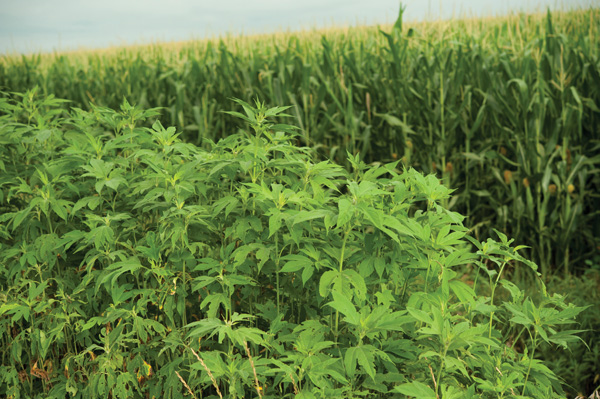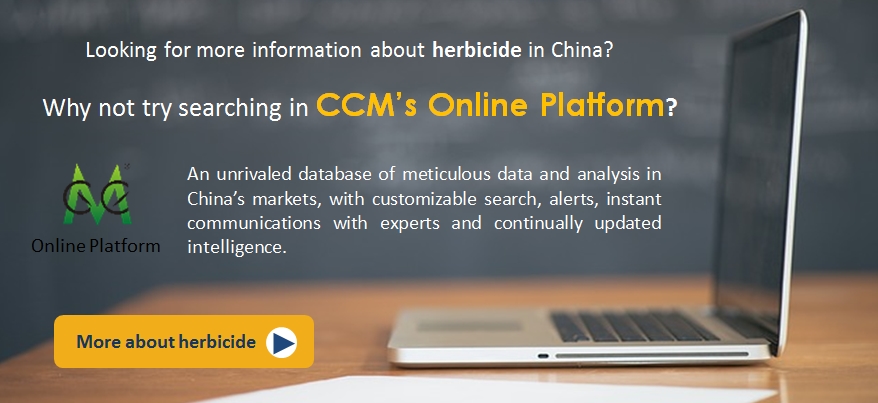Wang Jianwo, President of Hunan Association
of Professional Prevention and Control for Crop Diseases and Pests.

Source: Bing
* All the opinions presented here merely
belong to the author and to the author alone, they do not necessarily represent
CCM ' s points of view.
The use of glufosinate-ammonium, a
potential substitute for paraquat and glyphosate, is recently becoming greatly
diffused, but, on a market share matter, it is still far behind paraquat and
glyphosate, and its development is impeded by the blind expansion of production
capacity.
The market price of glufosinate-ammonium TC has now dropped from
USD54,208.94/t (RMB350,000/t) to USD20,909.16/t (RMB135,000/t), which makes it
meagerly profitable or even not profitable at all for enterprises. Industry
insiders have revealed that some small-scale production manufacturers have
gradually stopped producing glufosinate-ammonium and some are even planning to
exit the industry. While all the large-scale production manufacturers still
increase their inputs to compete for market shares.
Blind capacity expansion has brought
unexpected troubles – the irrational market competition and price war.
An unbalanced supply-demand relationship is
bound to lead to market fluctuation, with over-demand resulting in a price rise
and over-supply causing price falls. It is known that glufosinate-ammonium's
production capacity has been expanding since 2015, and this caused unexpected
troubles to the irrational market competition and price war.
"If we do not control its capacity
expansion, glufosinate-ammonium is bound to become soon a suffering comrade of
glyphosate. Now that disordered competition is increasing in the market, many
enterprises are forced to stop production," stated Zhao Jianqin, director
of HebeiVeyong Bio-Chemical Co., Ltd. (HebeiVeyong).
Capacity expansions of glufosinate-ammonium
at home and abroad:
Abroad: Bayer CropScience AG (Bayer
CropScience) is further expanding the capacity of glufosinate-ammonium TC and
intermediates as it invested USD200 million and USD5 million in constructing a
glufosinate-ammonium intermediate project and a glufosinate-ammonium TC
expansion project respectively.
After a construction period of two years, said
projects are expected to be put into production in mid-2017 and, when that time
comes, Bayer CropScience'sglufosinate-ammonium will break through 12,000 t/a.
Home: HebeiVeyong initiated the
construction of a 1,000 t/a glufosinate-ammonium TC project based on its 450
t/a production line. Also, its 3,000 t/a glufosinate-ammonium TC project is being
planning.
Zhejiang Funong Biotechnology Co., Ltd.
(formerly Zhejiang Yongnong Chem. Ind. Co., Ltd.) already owns a capacity of
3,000 t/a forglufosinate-ammonium TC.
Lier Chemical Co., Ltd.'s
glufosinate-ammonium TC capacity has reached 1,600 t/a and another 2,000 t/a
project is being constructed, a glufosinate-ammonium TC project (design
capacity: 17,600 t/a) has been included in the future planning as well.
Sichuan FuhuaTongda Agro-chemical
Technology Co., Ltd. (FuhuaTongda)'s 12,000 t/a glufosinate-ammonium project
invested in two phases has been put on record.
Inner Mongolia Jiaruimi Fine Chemical Co.,
Ltd. speeds up the construction of a 3,000 t/a glufosinate-ammonium project,
the first production line (600 t/a) has been put into operation and the other
four will be completed within two years.

De-capacity can boost the sustainable
development of the glufosinate-ammonium industry.
Sun Shubao, President of China Crop
Protection Industry Association pointed out that de-capacity, a technical
innovation, and safety in production are necessary for the sustainable
development of the glufosinate-ammonium industry.
Now, the overcapacity of some
pesticides has become one of the dangers for the transformation and upgrading
of China's pesticide industry. For the pesticide industry nowadays, China
should insist on the innovation-oriented strategy, and extend the industrial
chain from low to high level by improving the enterprises' technological
ability in order to solve the overcapacity.
"Enterprises must change the
traditional production and management modes through innovations in technology
and business and also actively participate in the new global technology reform
to achieve improvement in both quality and cost advantage," said Chen
Chengxin, president of Rosi Chemical Co., Ltd. (Rosi Chemical).
In recent
years, Rosi Chemical has taken efforts in the production route, product quality
and product yield, developing as a result a new production technique for
glufosinate-ammonium. With this technique, sodium cyanide and acrolein are no
longer needed for the production of glufosinate-ammonium, which was proved to
be safe, environmentally friendly and clean after small- and pilot-scale
production.
Transformation of production technique
should be taken seriously when developing glufosinate-ammonium in the future.
"Along with the aggravated
glyphosate-resistance of weeds and the ban of paraquat due to toxicity,
glufosinate-ammonium is bound to become an active substitute of these
herbicides that used to occupy important positions in the market.
However, it
is still hard for glufosinate-ammonium to compete with glyphosate and paraquat
on a production cost and safety in production matter," revealed Zhang
Yibing, formerly Senior Engineer of Shanghai Pesticide Research Institute.
Zhang Yibin believed that the method used
to develop by innovation is a vital concern in the development of
glufosinate-ammonium. In the future, enterprises should pay attention to the
transformation of the production technique – utilizing biological methods to
synthesize glufosinate-ammonium, achieving clean and safe production,
developing materials to improve the efficiency of herbicides, reducing the use
of per unit area, achieving consumption reduction and weeds control and finally
reducing the cost of use.
All pesticides, in addition, this will certainly
cause resistance of weeds after being used in a large quantity for a long time,
therefore, we need to pay close attention to it, take concrete steps to conduct
agrochemical services based on actual conditions and to guide the scientific
pesticide application.
GuoJingquan, Proffessor of the CropLife
Asia and an expert for pesticide development said that the ban on paraquat and
the undulating glyphosate market are both related to the products' safety. High-efficacy
and low-risk products have become a new development trend in the global
pesticide market.
This article comes from Glyphosate China Monthly Report 1605, CCM

About CCM:
CCM is the leading market intelligence provider for China's
agriculture, chemicals, food & ingredients and life science markets.
Founded in 2001, CCM offers a range of data and content solutions, from price
and trade data to industry newsletters and customized market research reports.
Our clients include Monsanto, DuPont, Shell, Bayer, and Syngenta. CCM is a
brand of Kcomber Inc.
For more information about CCM, please
visit www.cnchemicals.com or get in touch with us
directly by emailing econtact@cnchemicals.com or calling
+86-20-37616606.
Tag: glufosinate paraquat glyphosate